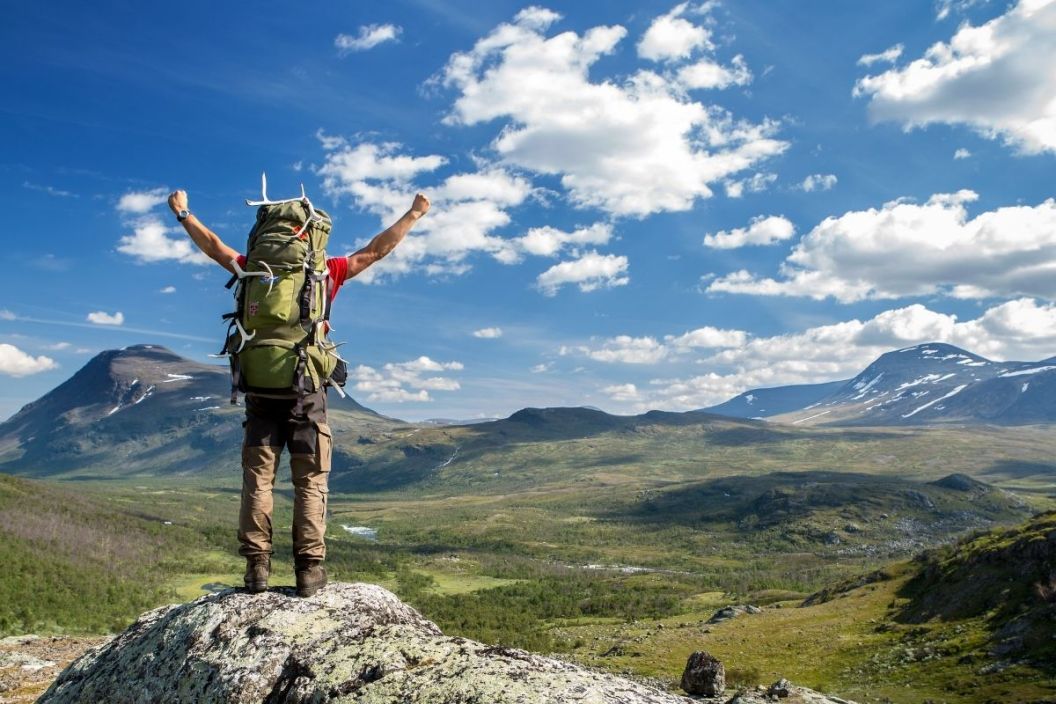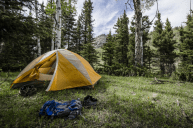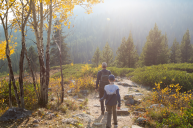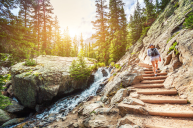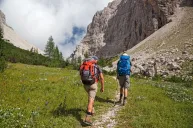Believe it or not, you don't have to travel all the way across the Atlantic Ocean to Europe just to go backpacking. In fact, there are plenty of opportunities to go backpacking in the USA, and maybe backpacking near home is a good idea before you venture out on a completely different continent. So if backpacking is on your bucket list, don't let the grand idea intimidate you.
Whether you're new to backpacking or an expert backpacker, it's pretty obvious that planning ahead will help your adventure run as smoothly as possible. So we've put together a travel guide consisting of what to think about when mapping out your journey. From budgets to itineraries, this basic outline will help you organize the kind of backpacking trip you want to take throughout America.
Backpacking USA: How to Plan Your Backpacking Adventure
Budgeting
This is incredibly important when planning your trip. Knowing how much you're willing to spend daily will affect the length of your trip, the kinds of places you'll visit, and how many places you'll get to visit throughout the entirety of your journey. If you plan well, you can spend as low as $50-$70 daily to cover lodging, groceries, bus tickets, and any other extra expenses. To take a closer look at what exactly you could be spending your money on, here's a simple breakdown of what your expenses would look like:
1. Lodging
Unless you are ready to blow some serious money, cheap accommodations will be important to find. If you thought hostels were only a concept in Europe, then you're about to be pleasantly surprised. There are actually a few hostels here in the US, and you can find them on hostelworld.com/hostels/north-america. You can also save money by checking out couchsurfing.com, a popular website used by avid travelers that connects you with people that allow you stay at their homes. And although it's a cheaper alternative to Airbnb, you should still consider the home rental website, too, using motels and hotels as your last resort.
Another option to consider is camping. Any traveler who has backpacked throughout the US can tell you that the easiest way to move through the country is by checking out all the national parks. Explore your options when it comes to campgrounds, including car camping areas if you're planning to take a road trip.
2. Food/Drink
Keep in mind that going out to eat gets incredibly expensive if you do it all the time. And where you'll be also makes a difference on how much dining out will cost. You should want to get groceries as much as possible when you're hanging out in an area, for however long.
3. Transport
If you're not road-tripping, there are plenty of alternatives to flying to every destination on your trip. You can take the Greyhound, a bus service that can take you to many cities across the US, or the Amtrak, a train option that essentially offers the same services. If you're exploring a major city, use public transportation instead of renting a car. Daily bus tickets run anywhere from $2-$5, and explore that city's local train options. If you can't reach a certain place by public transportation, ride share services are a fine alternative.
If you do plan to road trip, you'll have to factor in gas expenses, and if you want to rent a car for your trip, you'll have to consider the daily rental price. Renting a car or campervan runs anywhere from $30-$150 daily.
4. Leisure
Of course, this is the part that probably motivated your trip—to go see the country! Whether you're hiking in nature or walking around an urban city, you'll have to set aside funds to pay for entrance fees, permits, etc. However, you'd be surprised at how little you might have to pay to visit a city's cultural attractions if you properly research a city prior to your trip. Be intentional about what you want to see, and that should take a ton of stress off of planning your adventure.
Length of Your Trip
After you've decided how much you can spend on your journey, you can now figure out how long your backpacking trip will last. This is also important because the length of your trip will affect where you can go and what you can see. It's also important to decide what time of year you will be heading out on your journey, as that can affect which places you should head out to. Here are some options you can pick from that will help you formulate the outline of your trip's itinerary.
1. Backpacking in 10 Days
Although a 10-day trip is a relatively small amount of time, you can still make the most out of your trip. You'll most likely have to fly to your destinations in order to waste no more time on traveling, but you'll get to hit the best US cities, like San Francisco, Las Vegas, and New York City. If you fly into those cities, you can hit other areas near those places such as Yosemite National Park, the Grand Canyon, and Washington D.C.
2. Backpacking in Two Weeks
This amount of time will allow you to make road trips across regions. If you want to hit the Pacific Northwest, from Washington through Oregon into California, check out day hikes or hiking trails in Olympic National Park. If you decide you want to explore the Northeast instead, bounce around between the states that make up New England, including New Hampshire and Maine.
3. Backpacking in One Month
If you have a month to spare, then your options are almost endless. You can take multi-day, long-distance routes such as road-tripping from the West Coast to the East Coast. Hike the Appalachian Trail from Maine to Georgia, seeing the Great Smoky Mountains along the way. Take the Alaskan Passage ferry from Washington to Alaska, or make time to visit Hawaii without worrying about sacrificing any of the continental US.
Picking Your Destinations
RELATED: 11 Tips on How to Travel Cheap in the USA, From a Penny-Pinching Traveler
After you've decided the length of your trek across the US, you can finally get down to the fun part: picking your destinations. Of course, there's some creative strategy that comes with picking where you should go, but with every other part of your trip planned out first, it won't be difficult to narrow down the areas you should check out.
Depending on the length of your trip, start looking within regions around the US. You have the East Coast, New England, the Midwest, Appalachia, the South, the Great Plains, the Rockies, the Southwest, the West Coast, Hawaii, and Alaska to choose from. Factor in how difficult it would be to get from Arizona to Tennessee, as opposed to Utah from Colorado, or from Michigan to Florida, as opposed to Montana from Nevada.
And although I won't shy away from recommending that you visit the major urban cities during your trip, an ideal backpacking trip consists more of visiting wilderness areas, such as national and state parks. Hikers who are backpacking will take on longer trails in the backcountry such as the 40-mile Teton Crest Trail in Wyoming or the three week long John Muir Trail that has multiple trailheads. And your choices of national parks are endless. Here are some of our favorites:
Rocky Mountain National Park
Glacier National Park
Grand Teton National Park
Zion National Park
Yellowstone National Park
Mount Rainier National Park
Have you ever backpacked across the United States? Share your adventures with us on our Wide Open Roads Facebook!
